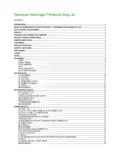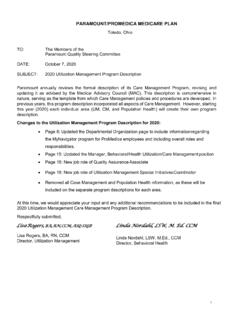Transcription of POLICY: PG0203 MEDICAL POLICY: Skin Substitutes and LAST ...
1 POLICY: PG0203 ORIGINAL EFFECTIVE: 01/15/09 LAST REVIEW: 10/8/2019 MEDICAL POLICY: Skin Substitutes and Wound repair Procedures GUIDELINES This policy does not certify benefits or authorization of benefits, which is designated by each individual policyholder contract. Paramount applies coding edits to all MEDICAL claims through coding logic software to evaluate the accuracy and adherence to accepted national standards. This guideline is solely for explaining correct procedure reporting and does not imply coverage and reimbursement. DESCRIPTION The addition of skin Substitutes or cellular or tissue based products (CTPs) to certain wounds may afford a healing advantage over dressings and conservative treatments when these options appear insufficient to affect complete healing. There are currently a wide variety of bioengineered products available for soft tissue coverage to affect closure.
2 These products may be derived from allogeneic, xenogeneic, synthetic sources or a combination of any or all of these types of materials. However, without the component of the recipient s own distinct epithelium and cellular skin elements, permanent skin replacement or coverage by the graft cannot be accomplished. As a clinical practice guideline and checklist to wound care, the concept of DOMINATE is an effective and efficient standard of care in improving wound care. DOMINATE guidelines include Debridement of necrotic tissue and biofilm, Offloading (especially diabetic) wound, Moisture balance (also rule out Malignancy and adjust Medications which may be impairing healing), Infection and Inflammation control, Nutrition to assist healing, Arterial assessment to insure adequate perfusion for healing, Technical Advances, Edema control and Education (offloading, abstinence from tobacco, blood sugar control, swelling control).
3 For diabetic foot ulcers and venous stasis ulcers, it is generally felt that if after one month of good wound care (which employs DOMINATE), there has not been a significant reduction in wound measurements (40 50%), then it is unlikely the wound will heal by 3 months and it is reasonable and even recommended that a different approach be taken. At that time, considering Technical Advances (T) can improve healing outcomes. It is then that cellular and tissue based products (skin Substitutes ) may be appropriate. It should be noted that the DOMINATE category Technical Advances also includes consideration for negative pressure wound therapy as well as hyperbaric oxygen therapy both of which can improve the wound bed in preparation for CTPs. Future advances in wound care may positively affect the timing for using these substitute skin products and this should be kept in mind (WOUNDS 2014;26(1):1-12).
4 POLICY HMO, PPO, Individual Marketplace, Elite Cellular or tissue based products (CTPs) Q4101, Q4102, Q4103, Q4104, Q4105, Q4106, Q4107, Q4108, Q4110, Q4111, Q4115, Q4117, Q4118, Q4121, Q4122, Q4123, Q4124, Q4126, Q4127, Q4128, Q4131, Q4132, Q4133, Q4134, Q4135, Q4136, Q4137, Q4140, Q4141, Q4145, Q4146, Q4147, Q4148, Q4151, Q4152, Q4153, Q4154, Q4156, Q4157, Q4158, Q4159, Q4160, Q4161, Q4163, Q4164, Q4165, Q4166, Q4169, Q4172, Q4173, Q4174, Q4175, Q4177, Q4178, Q4186, Q4187, Q4195, Q4196, Q4197 do not require prior authorization. All other skin Substitutes are considered to be "biologic wound dressings" which are part of the relevant service provided and not separately payable. Code 46707 is non-covered. Advantage Cellular or tissue based products (CTPs) Q4101, Q4102, Q4103, Q4104, Q4105, Q4106, Q4107, Q4108, Q4110, Q4111, Q4112, Q4113, Q4114, Q4115, Q4116, Q4117, Q4121, Q4123, Q4131, Q4132, & Q4133, Q4158, Q4176-Q4182, Q4186, Q4195, Q4196 do not require prior authorization for Advantage.
5 All other skin Substitutes are considered non-covered. Code 46707 does not require prior authorization for Advantage. HMO, PPO, Individual Marketplace, Elite, Advantage Application of CTPs for the treatment of lower extremity ulcer disease will be covered when the following conditions are met and documented as appropriate for the individual patient: 1. Presence of neuropathic diabetic foot ulcers for greater than four weeks duration 2. Presence of venous stasis ulcers of greater than one month duration that have failed to respond to documented conservative measures for greater than one month duration 3. Presence of neuropathic diabetic foot ulcers that have failed to respond to documented conservative measures for greater than one-month duration. These measures must include appropriate steps to offload pressure during treatment. 4. Presence of partial or full-thickness ulcers 5. Measurements of the initial ulcer size, the size following cessation of any conservative management and the size at the beginning of skin substitute treatment.
6 In all cases, the ulcer must be free of infection and underlying osteomyelitis. Documentation must support that these conditions have been successfully treated, resolved, prior to instituting skin substitute treatment. CTPs are covered only if they meet FDA approval for that intended usage and patient type ( , pediatric or adult), and have sufficient scientific evidence to support their application. The supply of CTP graft(s) should be reported separately in conjunction with the application 15271- 15278. Select the appropriate code from 15271-15278 based upon location and size of the defect. For biological implant for soft tissue reinforcement, use 15777 in conjunction with primary procedure. CTPs may be used on burns when skin grafting is not the appropriate option. These covered bioengineered skin Substitutes are expected to function as a permanent replacement for lost or damaged skin.
7 They may be used for temporary wound coverage or wound closure as appropriate and medically necessary. A single application of CTP for any particular ulcer is usually all that is required to affect wound healing in those wounds that are likely to be helped by this therapy. More than three applications to a single wound are usually not expected. If CTP applications and re-applications show no significant improvement after three separate treatments, additional re-applications are inappropriate and other treatment modalities should be considered. CTP treatments should not last more than twelve weeks. Improvement of fifty per cent or greater must be documented in the MEDICAL records for the reimbursement of additional re-applications after twelve weeks of treatment. If after twelve weeks the MEDICAL records do not support the significant improvement of the wound using the CTP treatments, Paramount may recoup any inappropriate reimbursement.
8 Since application of CTP is considered a physician service, it must be applied by either a physician or a nonphysician practitioner (NPP), and NOT by non-advanced practice nurses, therapists or MEDICAL assistants. CTPs are not separately reimbursable in any institutional setting, including long-term care facility, hospital inpatient, outpatient, or emergency room place of service. Wound preparation is considered part of the procedure. All products, including dressings, are included in the evaluation and management service and are not separately reimbursable. Claims submitted with unlisted code Q4100 will be denied if the product is a non-covered treatment. An invoice is required for unlisted code Q4100 for covered treatments. Reimbursement is based on review of the product reported per an individual claim basis. The following treatments for wound care are considered experimental and investigational because there is inadequate evidence in the peer-reviewed MEDICAL literature to support their clinical effectiveness (this list may not be all-inclusive).
9 Adherus Dural Sealant AlloMax for indications other than breast reconstruction AlloSource cryopreserved human cadaver skin AmnioCare AmnioExCel AmnioFix AmnioGenix AmnioHeal amniotic membrane Amniomatrix AmnioMTM AmnioShield AmnioStrip Amniotic fluid injection for corneal wound healing and for prevention of adhesions after orthopedic surgery Amniox (human embryonic membrane) for tarsel tunnel repair and all other indications Architect ECM Architect PX Artacent Wound Artelon (poly[urethane urea] elastomer) for anterior cruciate ligament reconstruction, rotator cuff repair , trapezio-metacarpal joint osteoarthritis and all other indications Arthres GraftRope for acromio-clavicular joint separation reconstruction Avotermin for improvement of skin scarring BioDexcel BioDfactor/BioDfence human amniotic allograft BioDfence Dryflex BioDmatrix BioDRestore Elemental Tissue Matrix Biostat Biologx fibrin sealant for wound healing and all other indications Biotape reinforcement matrix for soft tissue augmentation and all other indications CellerateRX Clarix 100 Clarix Cord 1K CollaFix Conexa reconstructive tissue matrix CorMatrix ECM Patch for cardiac tissue repair and all other indications Cortiva Allograft Dermis C-QUR biosynthetic mesh CRXa CYGNUS Cymetra injectable allograft for wound healing Cytal Burn Matrix Cytal Multilayer Wound Matrix Cytal Wound Matrix Dehydrated human amniotic membrane allograft ( , AmnioPro.)
10 BioFix and FlowerPatch) DermaClose continuous external tissue expander for facilitation of wound closure and all other indications DermaMatrix (formerly InteXen) Porcine Dermal Matrix for wound healing and other indications other than breast reconstruction DryFlex (human amnion allograft) for shoulder repair and all other indications DuraGen Plus dural regeneration matrix for surgical repair of soft tissue deficiencies and all other indications DuraMatrix DuraSeal Durepair Regeneration Matrix Endoform Dermal Template ENDURAGen Epicord (non-coverage for the Advantage Product line, per Ohio Department of Medicaid (ODM) fee schedule) Epidex EPIFLO transdermal continuous oxygen therapy for wound healing Equine-derived decellularized collagen products ( , OrthADAPT, Unite, and Unite Biomatrix) E-Z Derm for wound healing and all other indications Evicel fibrin sealant for repair of cerebrospinal fluid leakage and all other indications Excellagen FloGraft Fortaderm Fortaderm Antimicrobial Fortiva Porcine Dermis; GORE BIO-A Fistula Plug Guardian HydroFix Inforce Interfyl LiquidGen MariGen Matriderm MediHoney Medeor Menaflex Collagen Meniscus Implant Meso BioMatrix MIRODERM Neoform Dermis for wound healing.

















